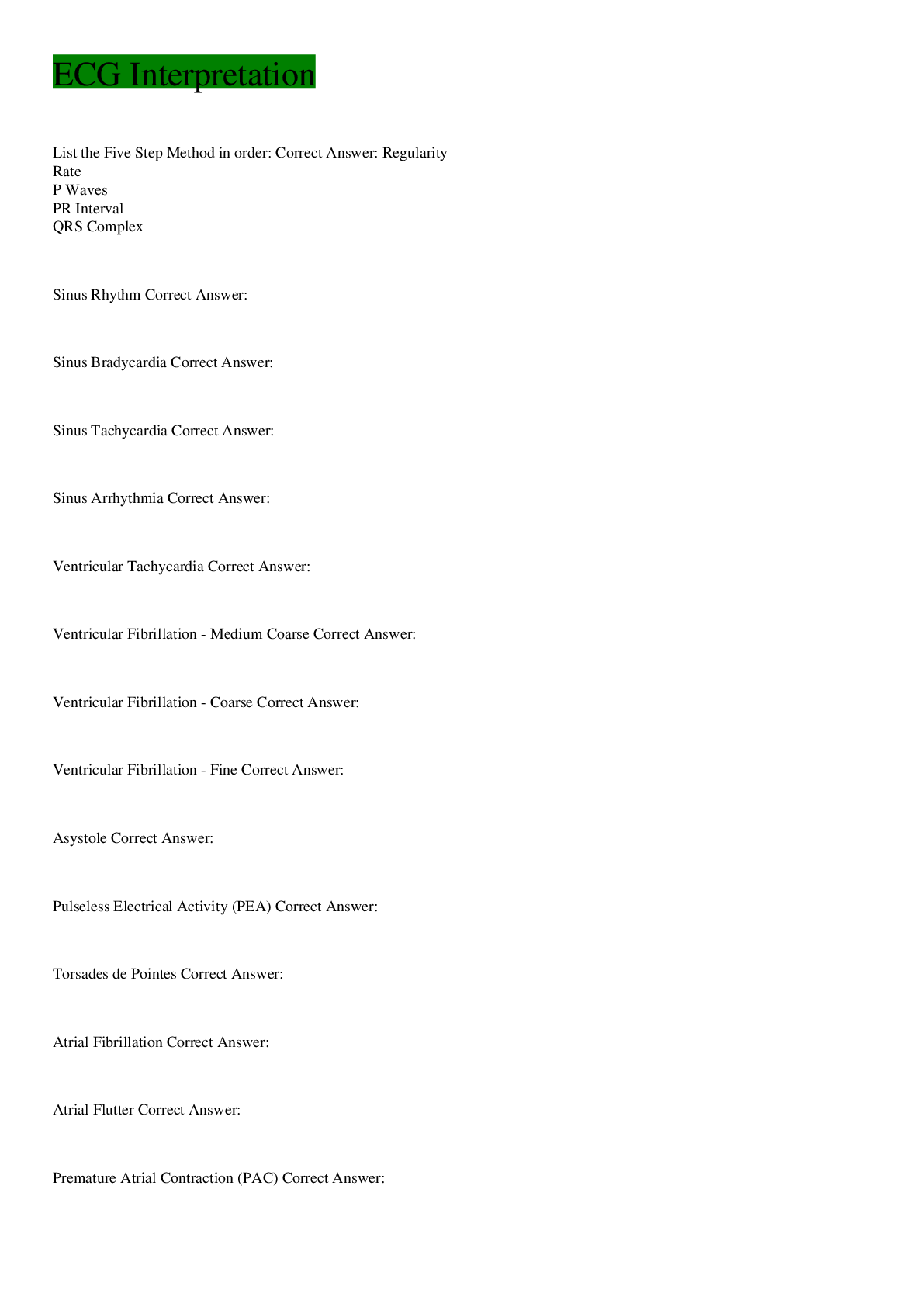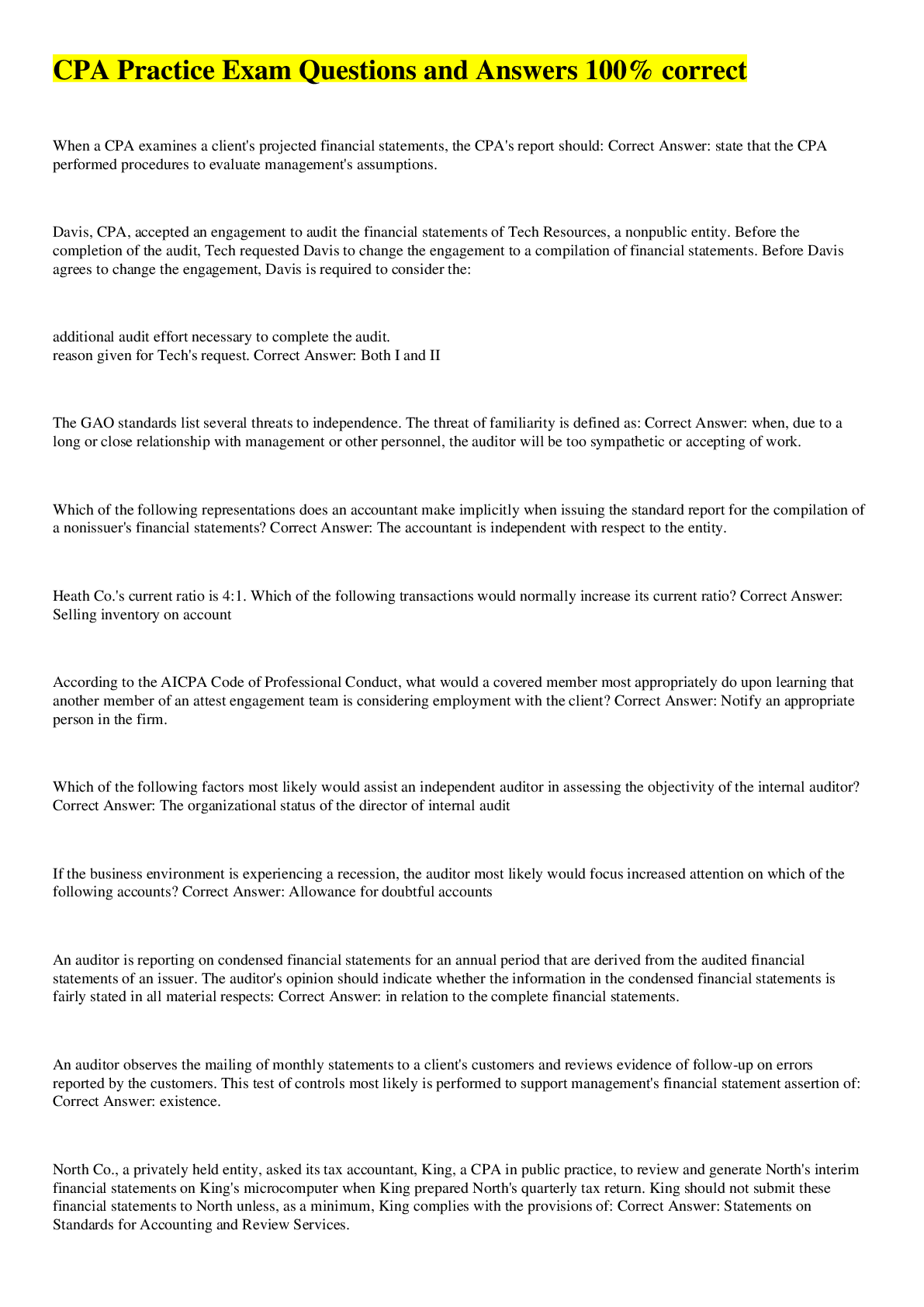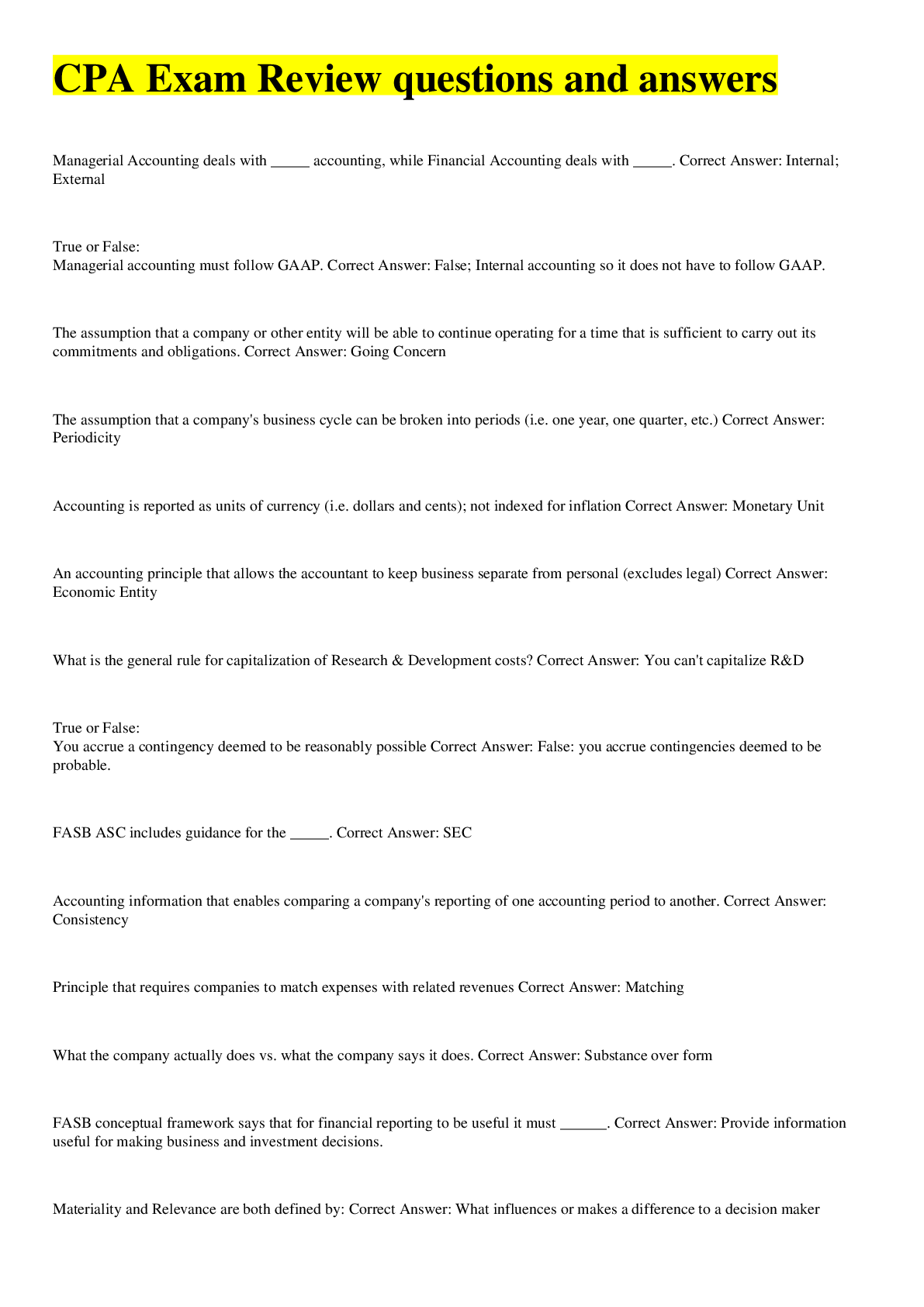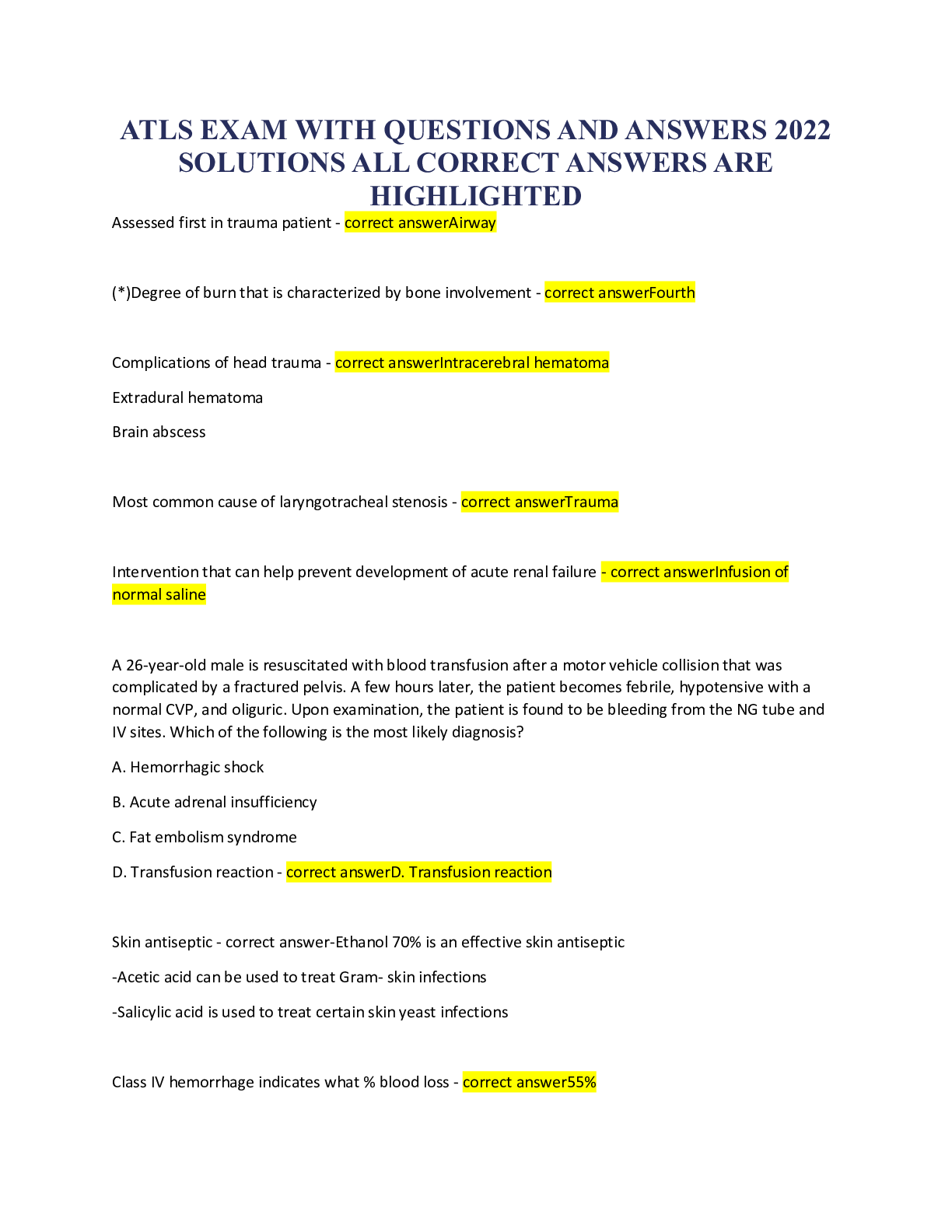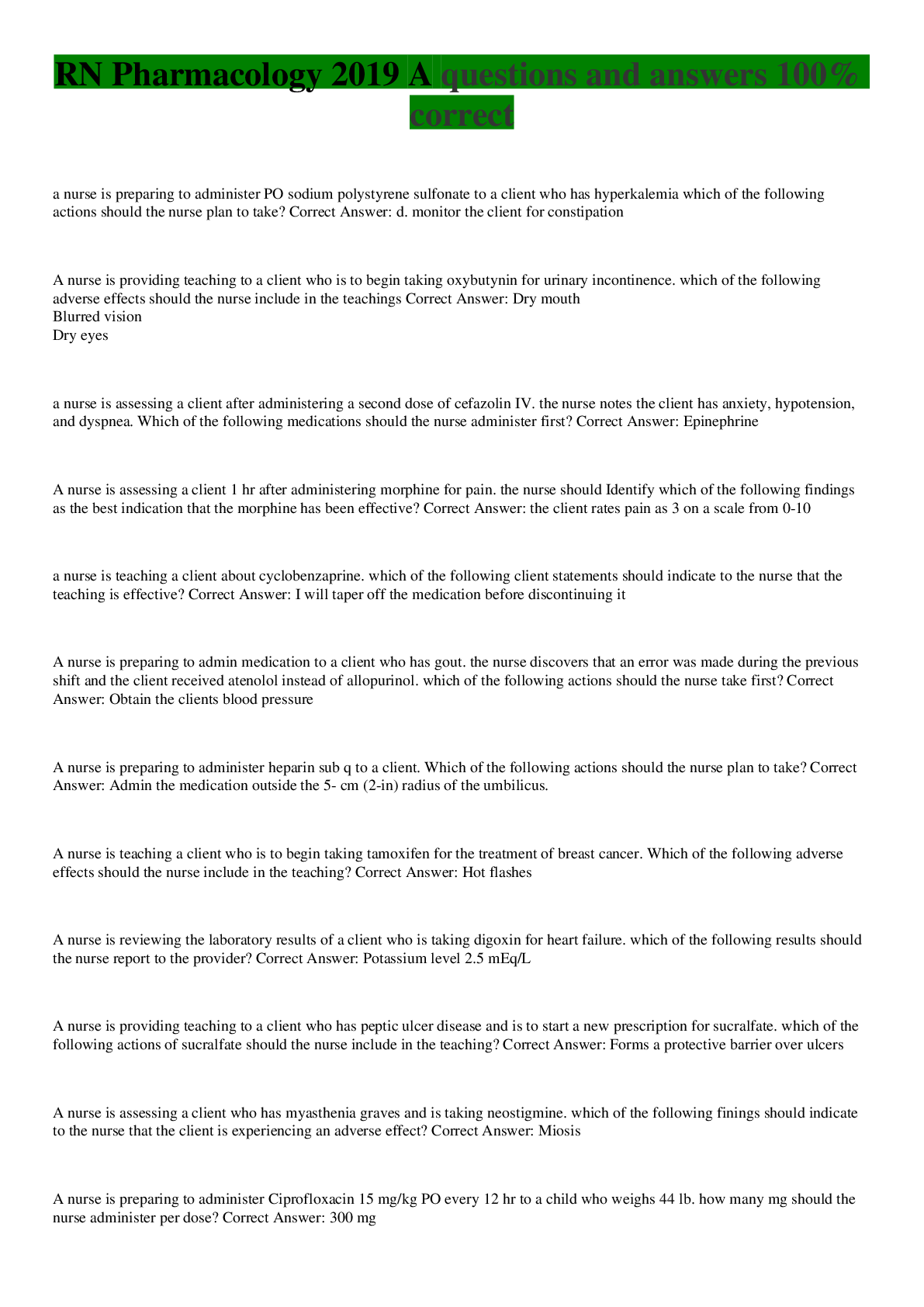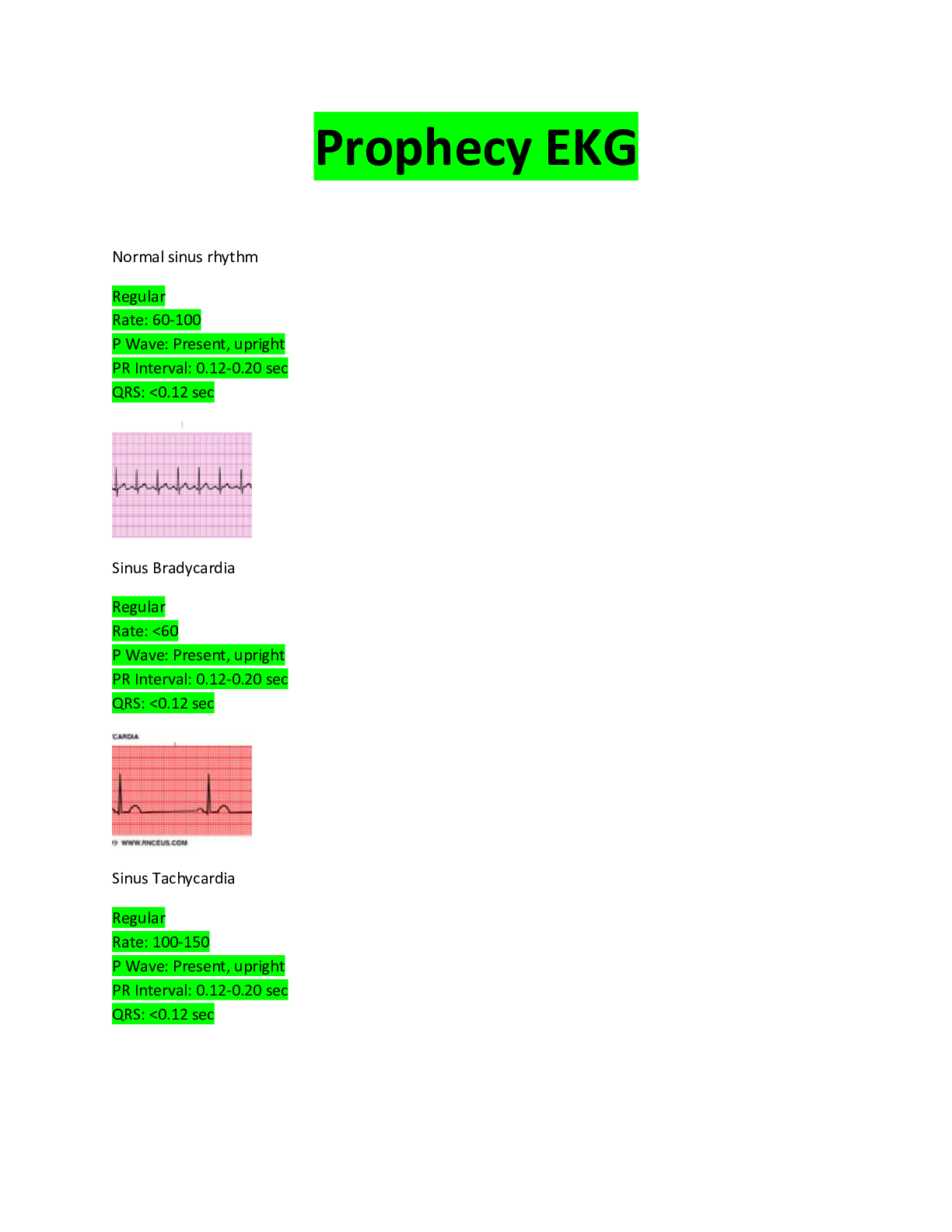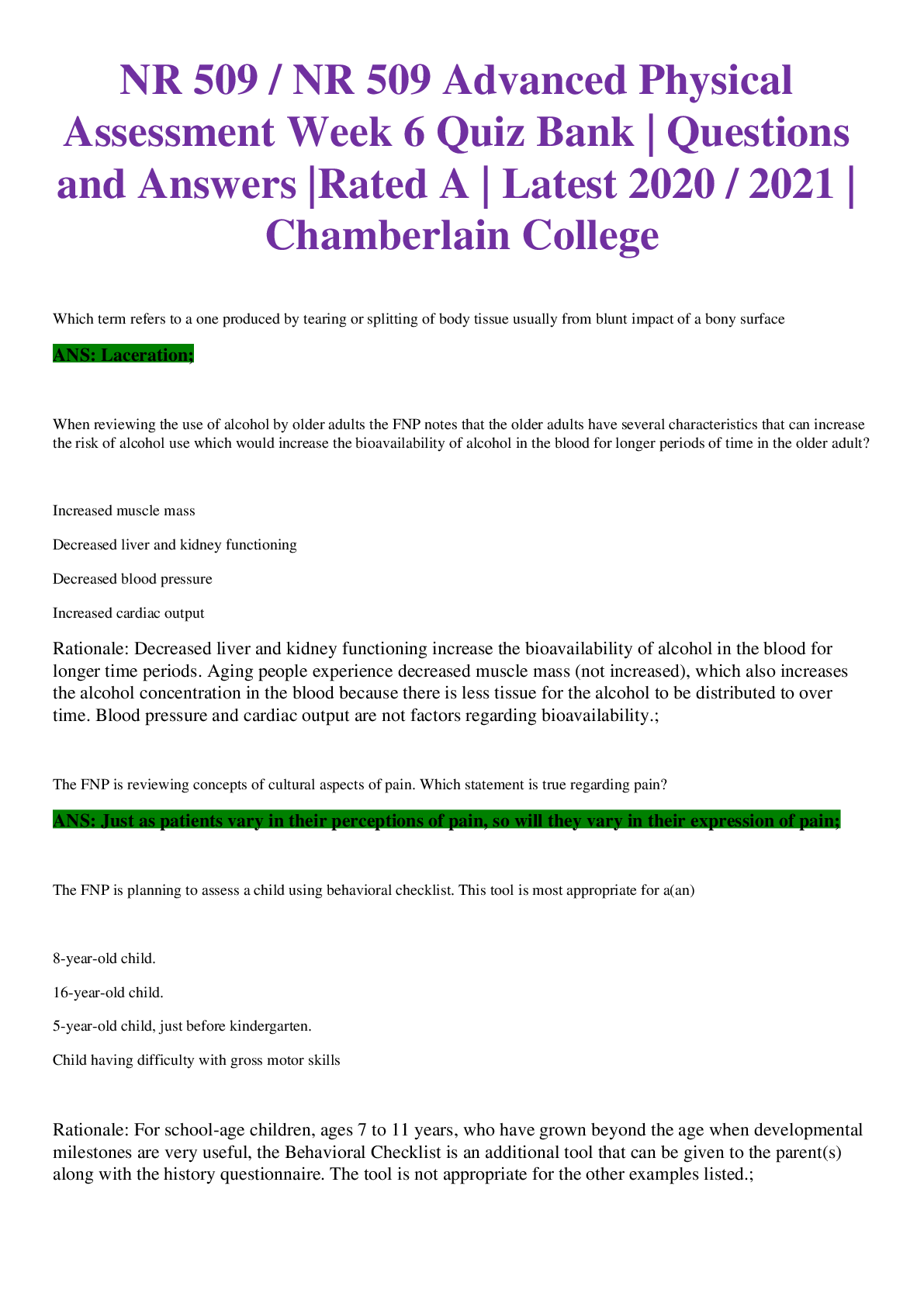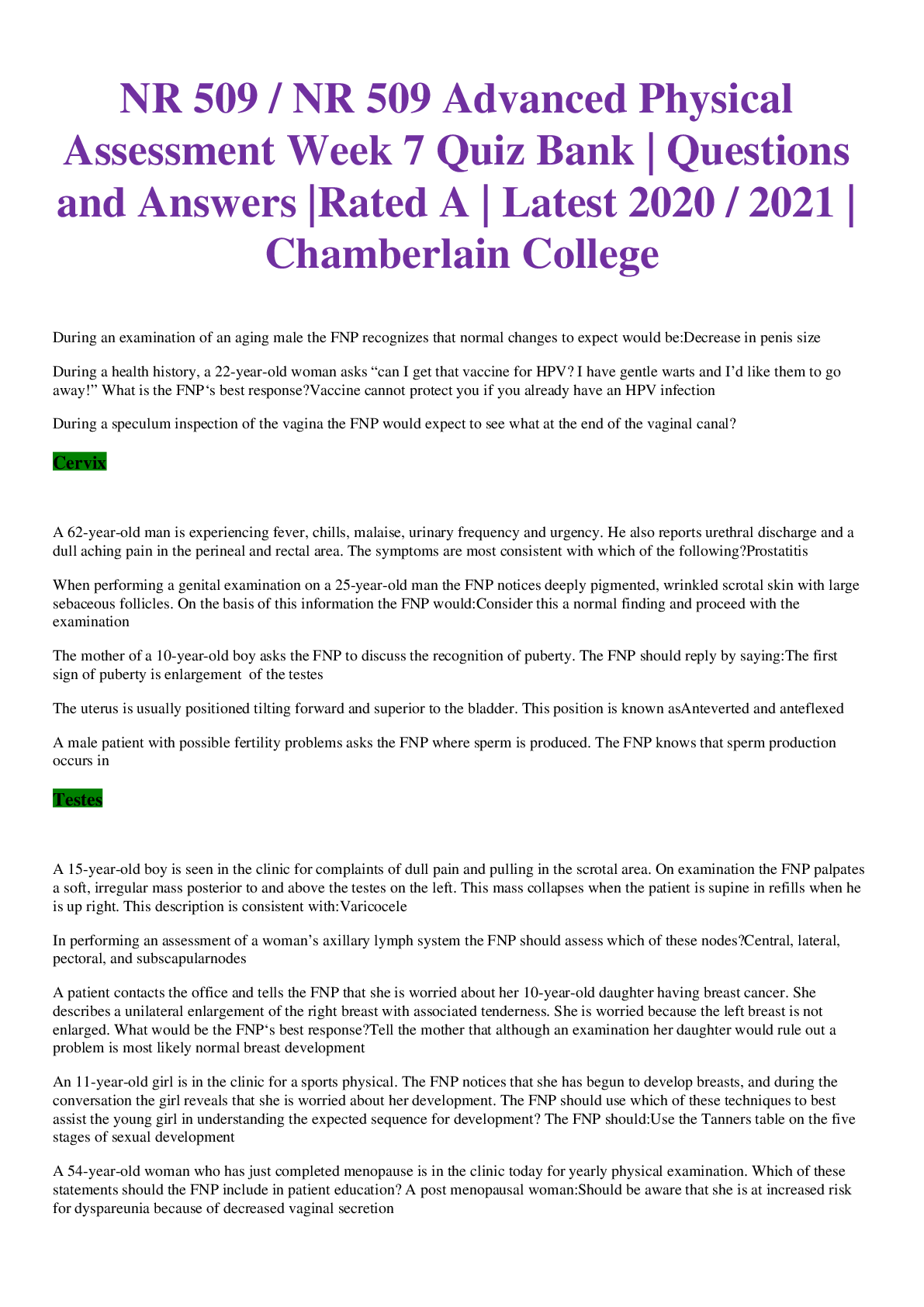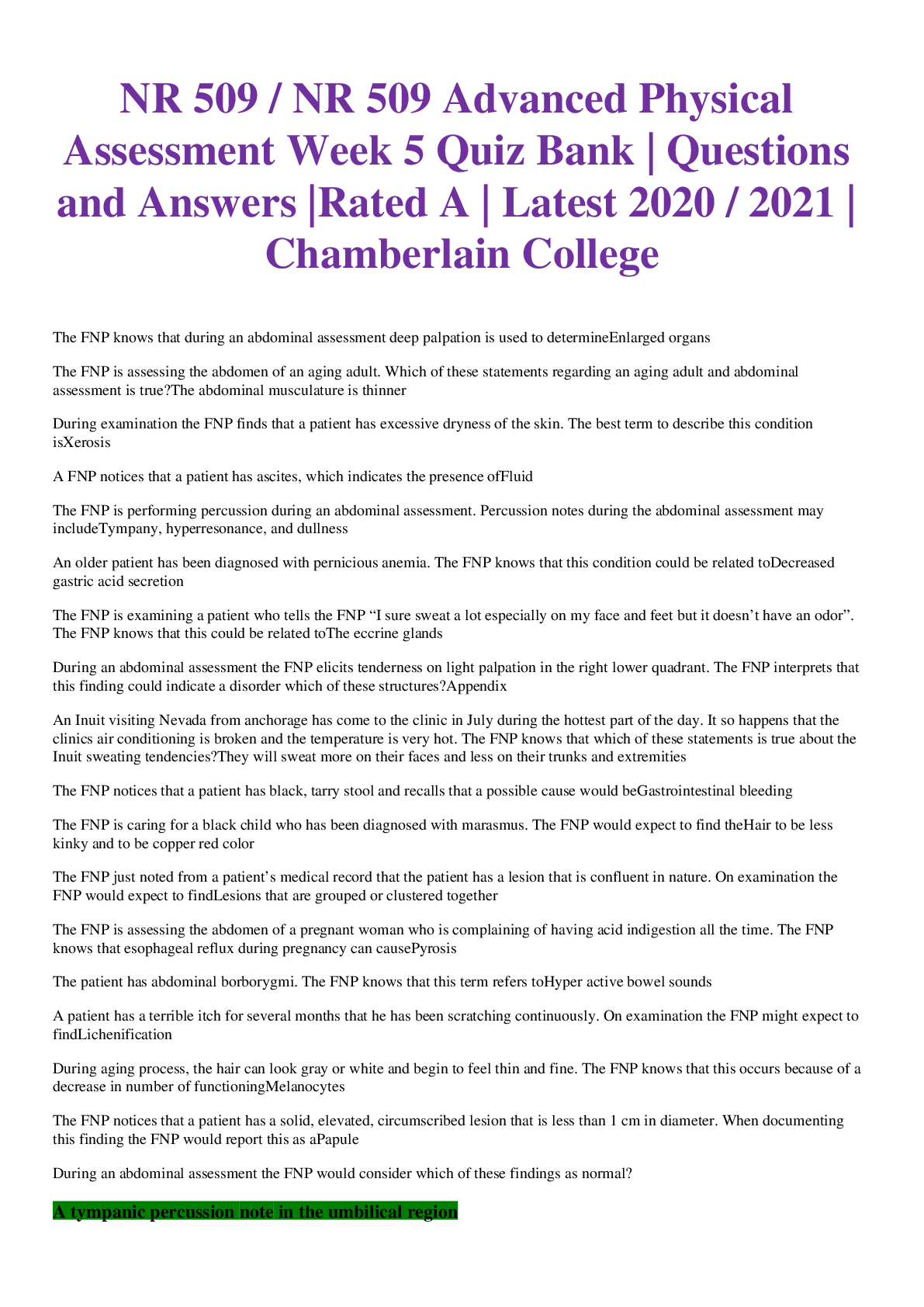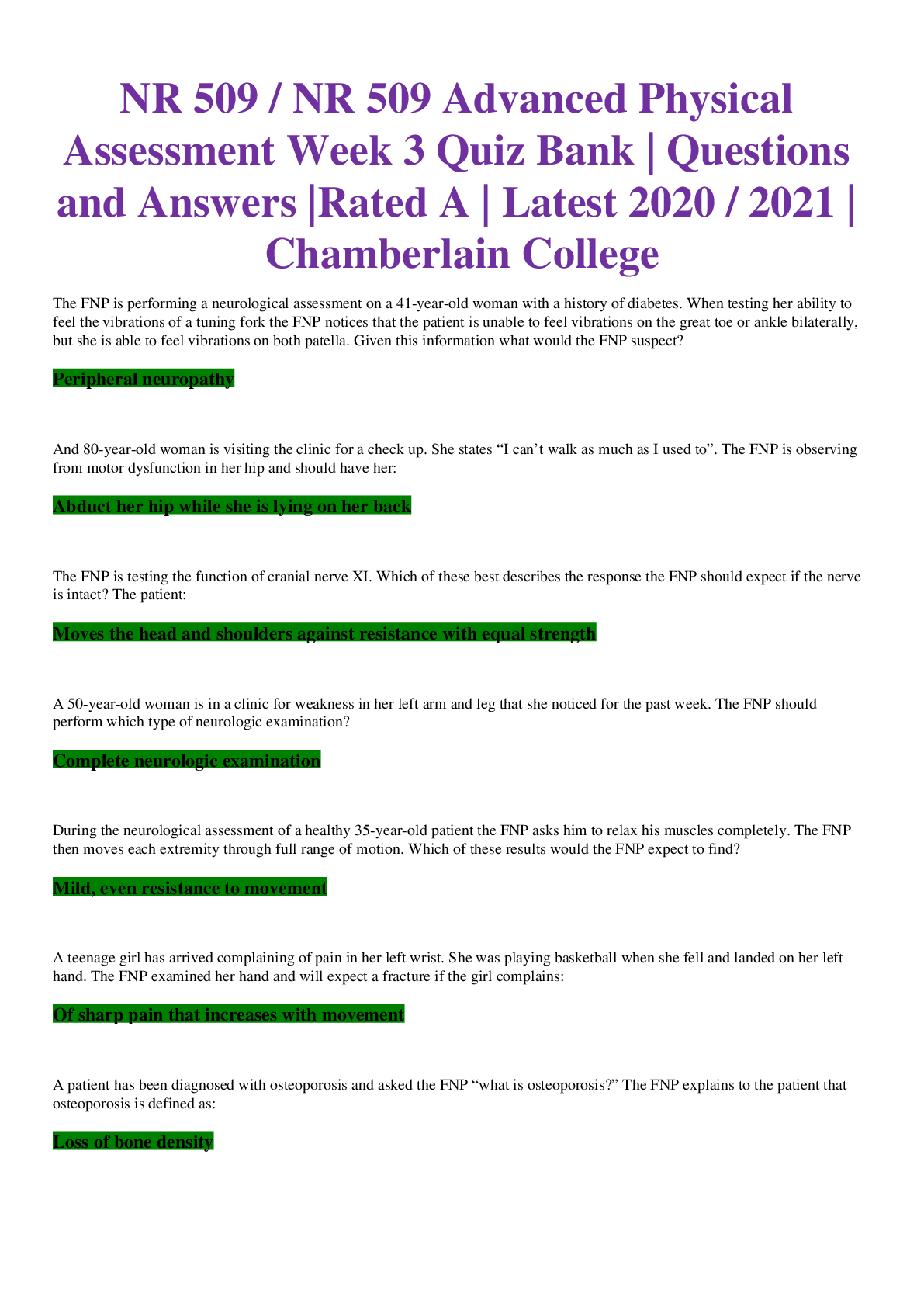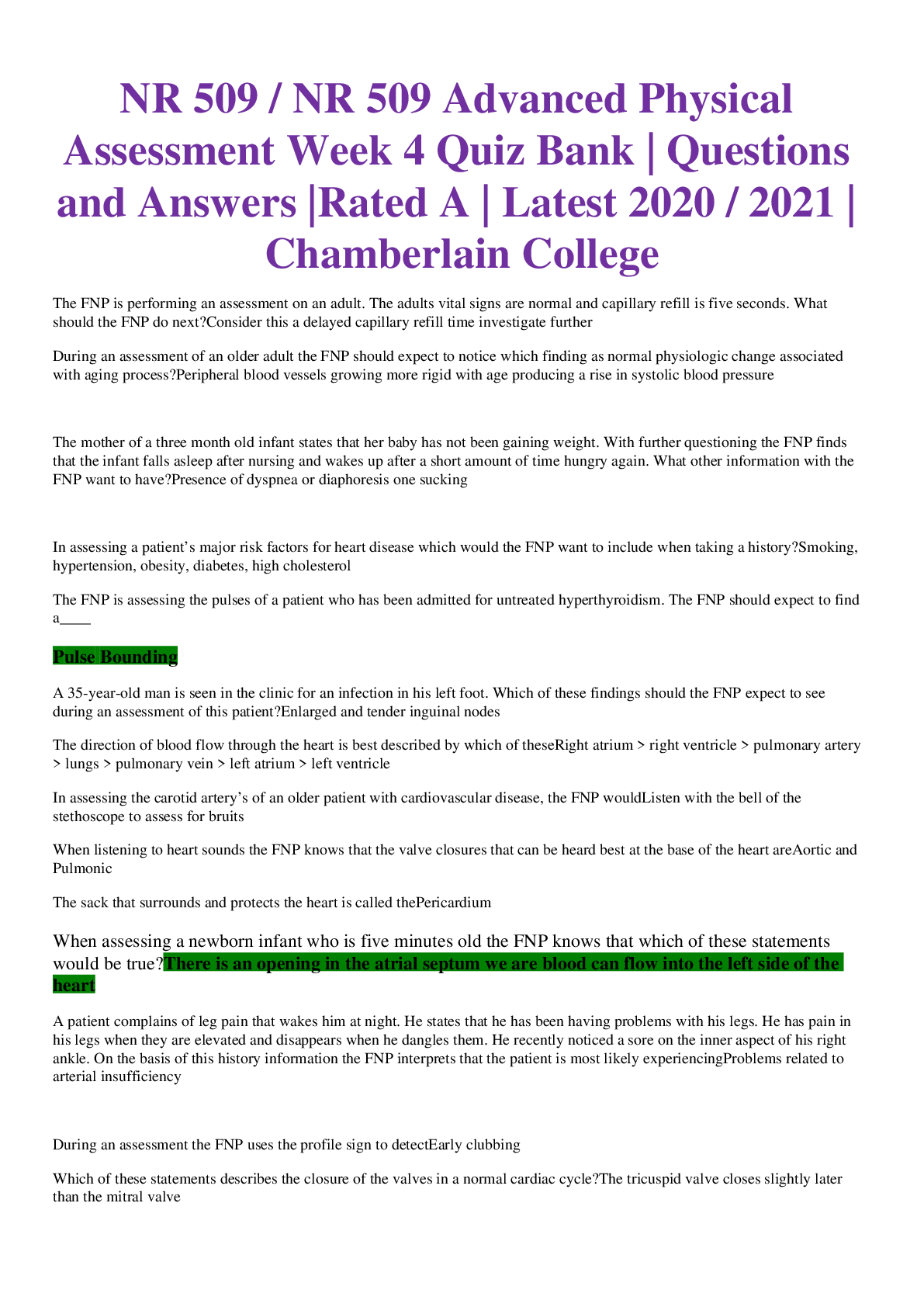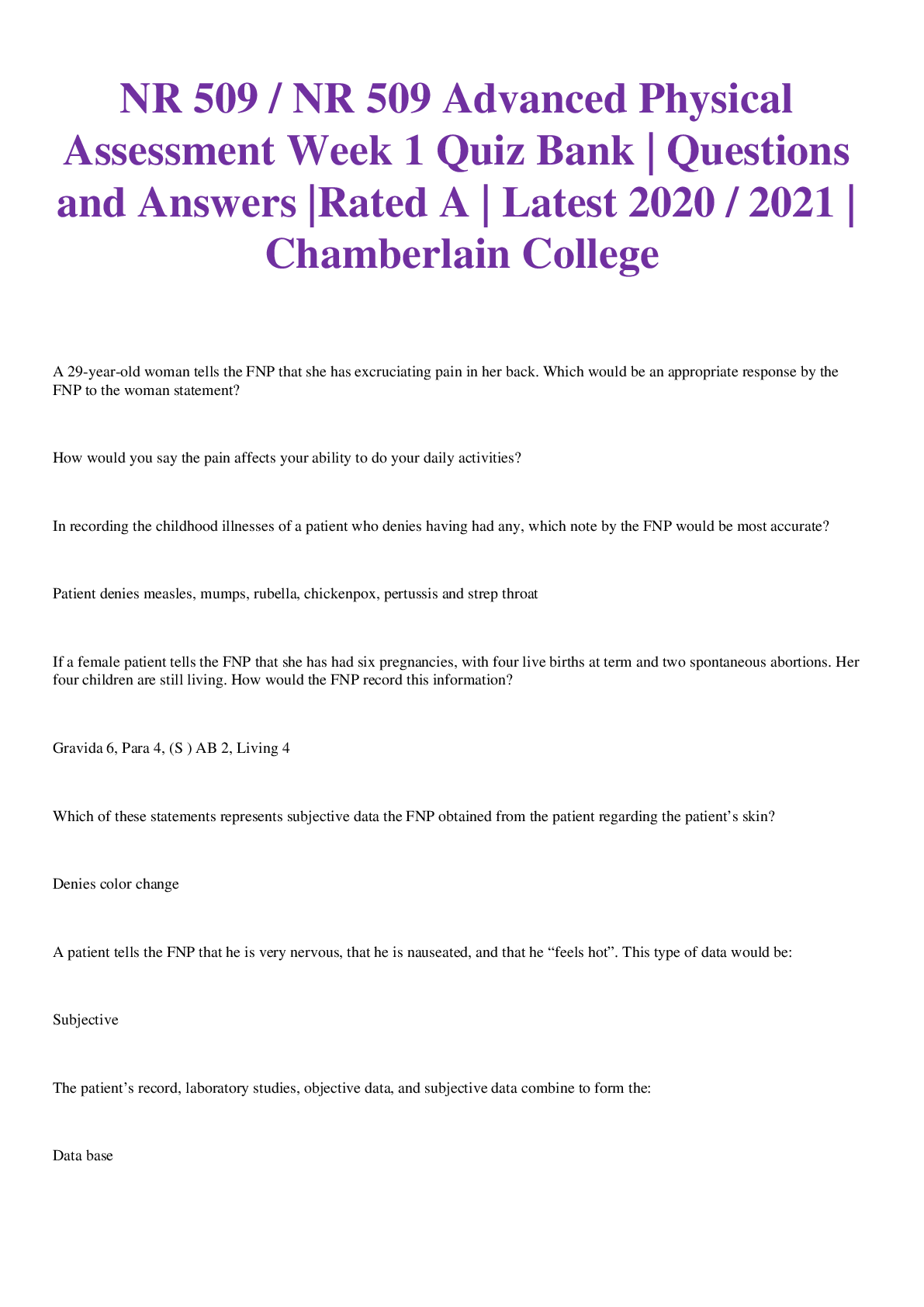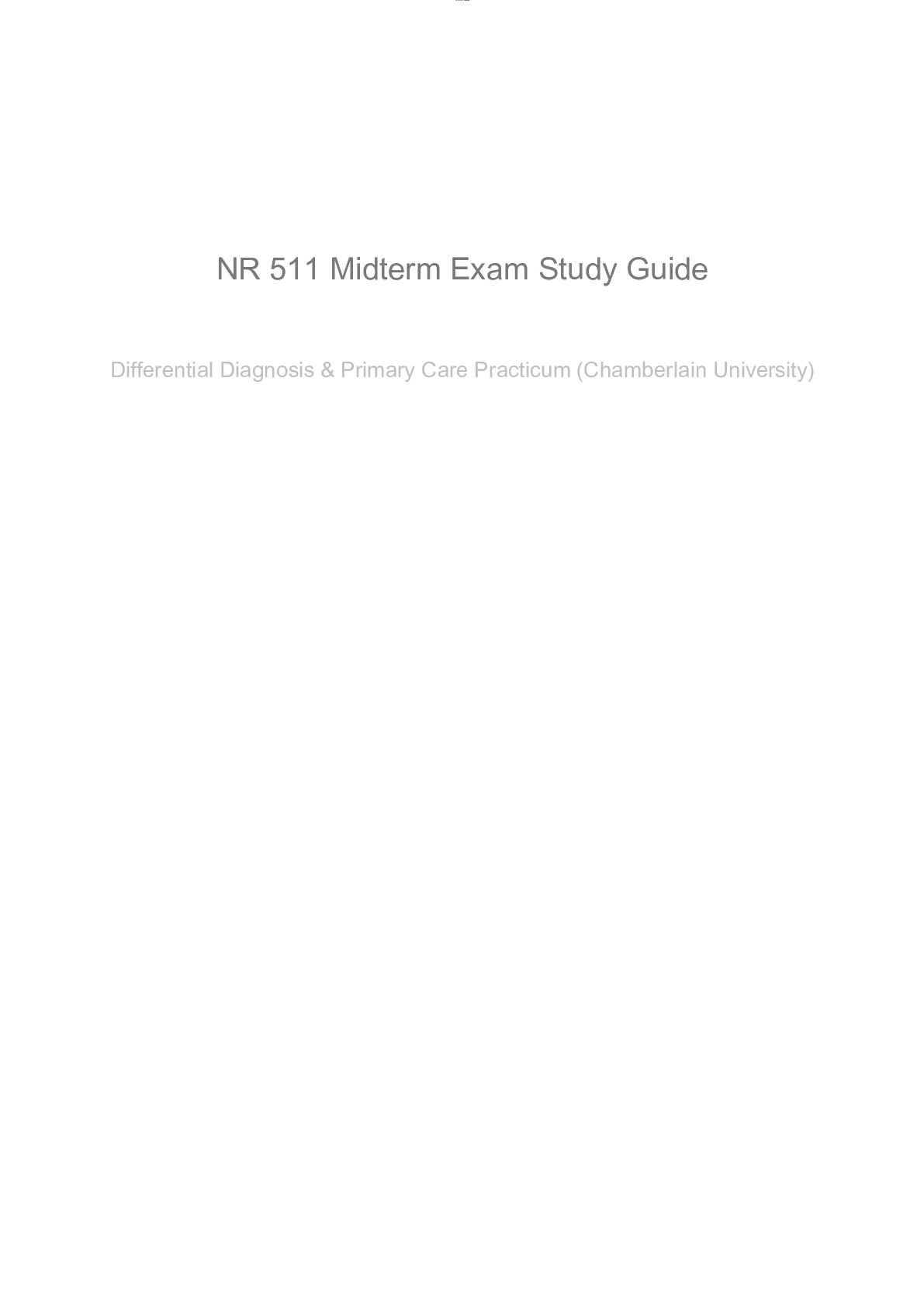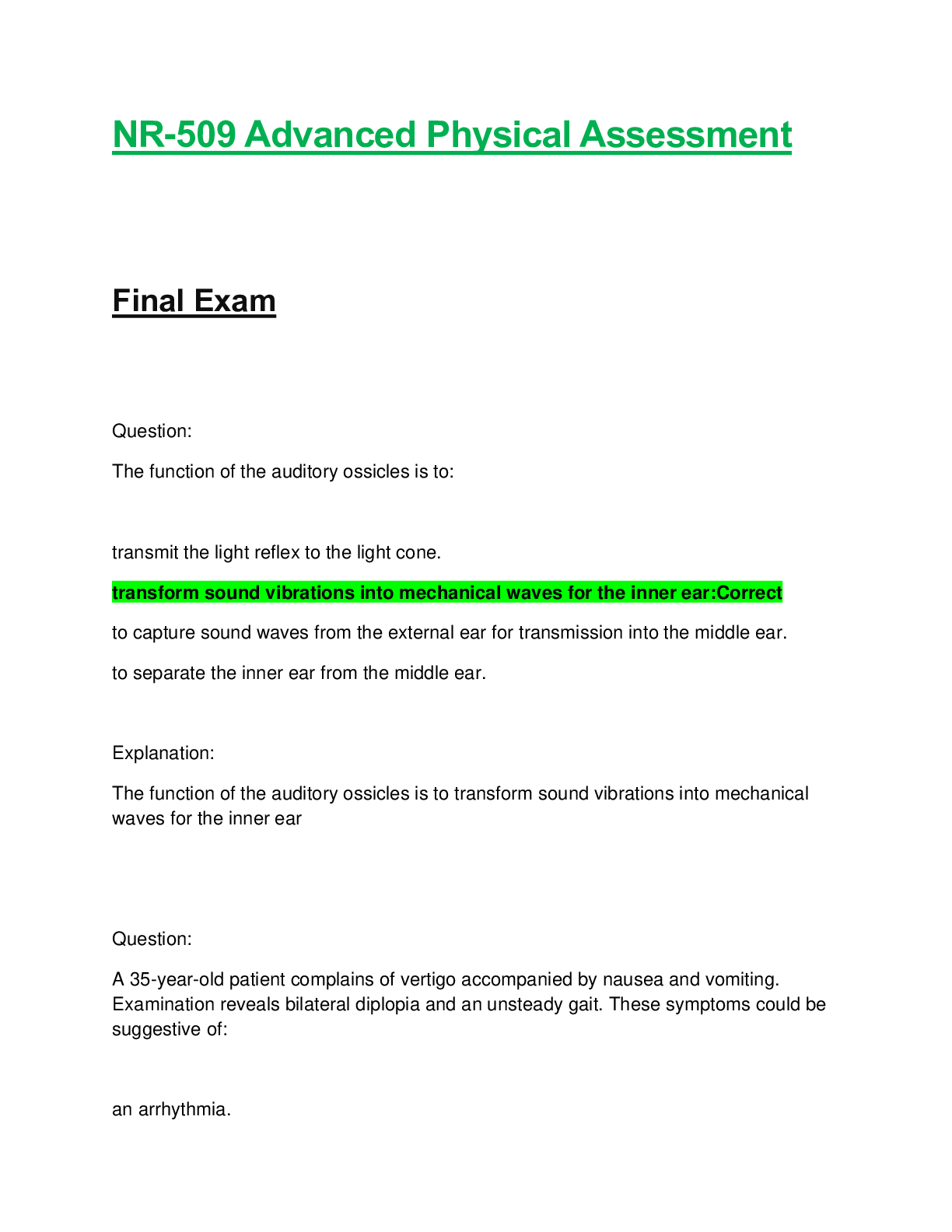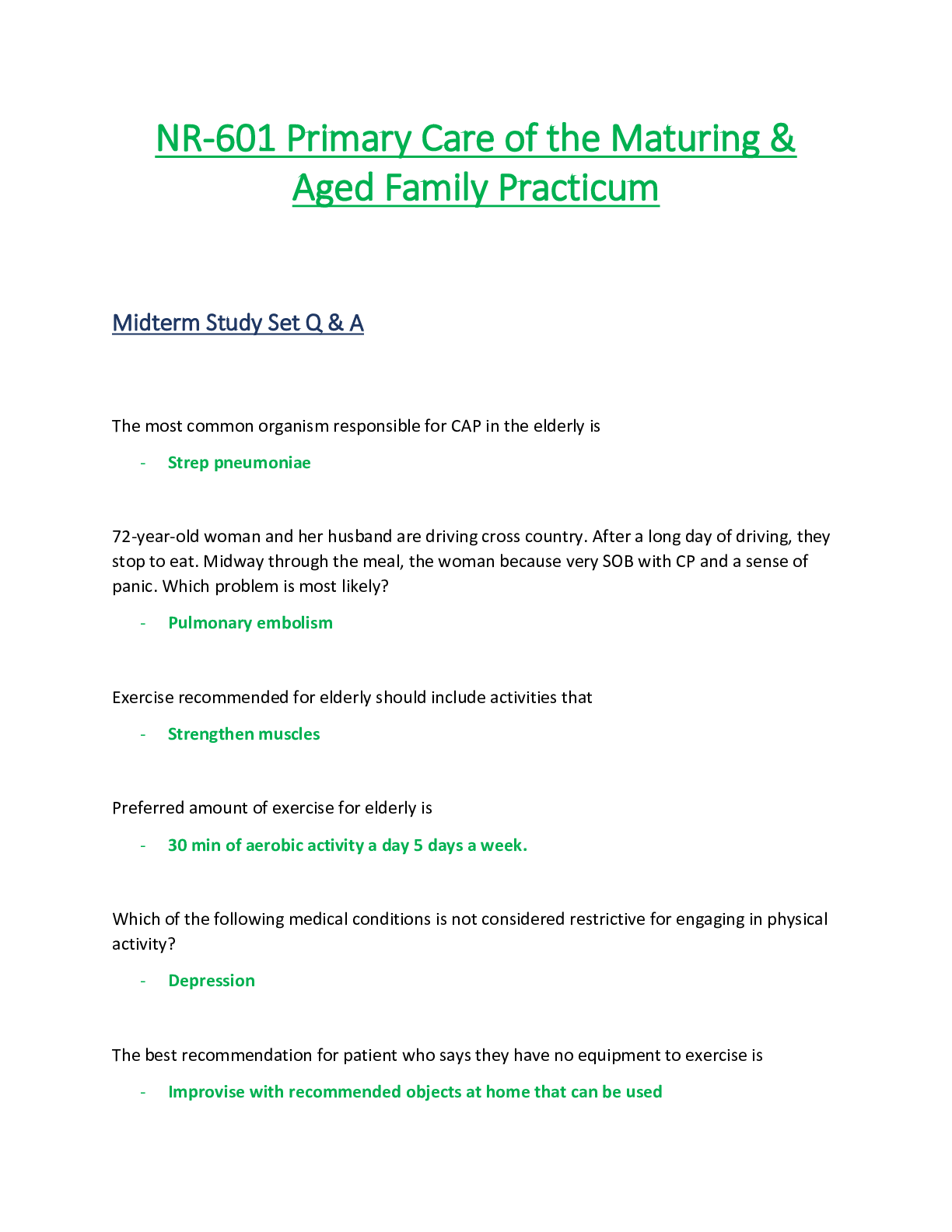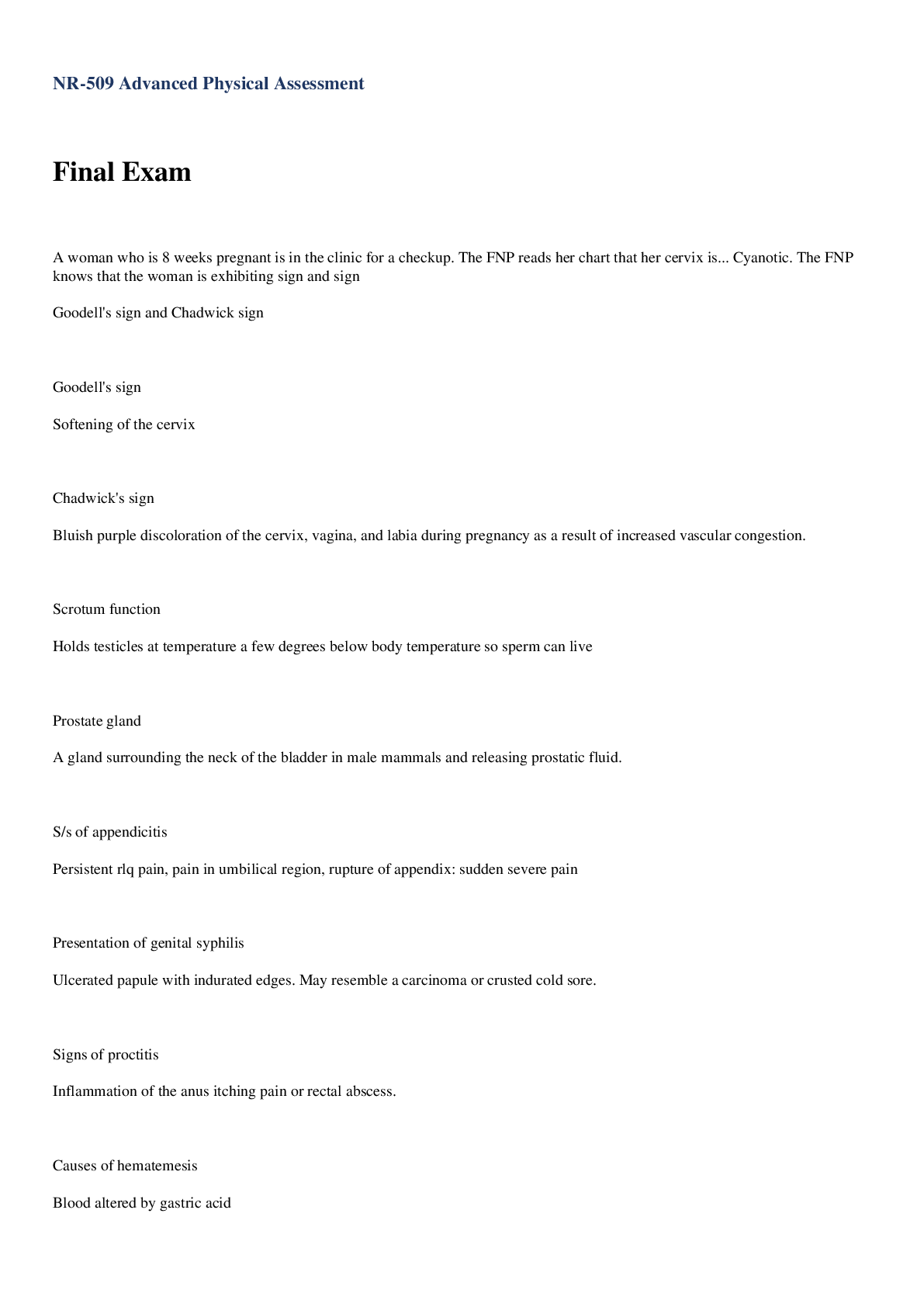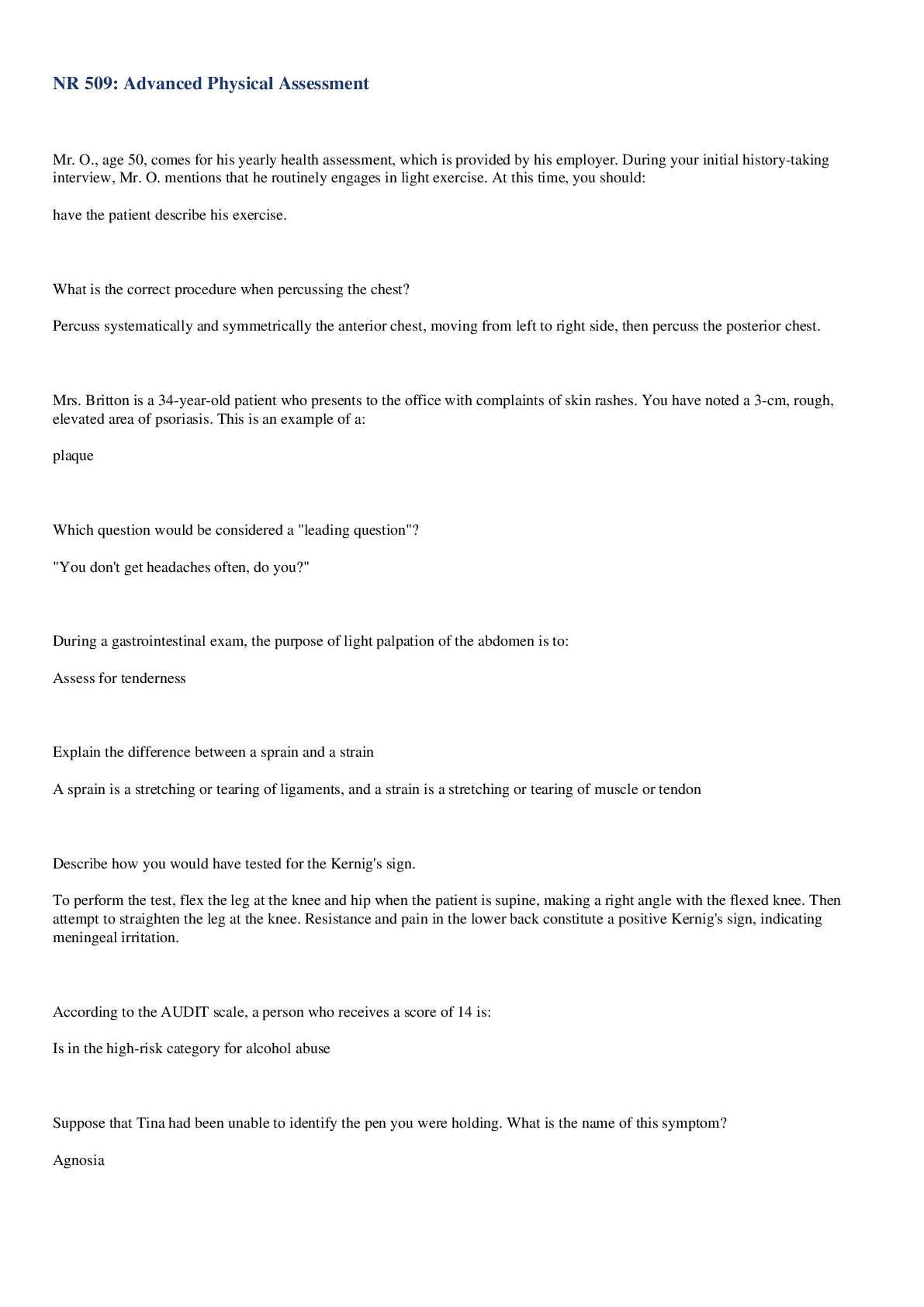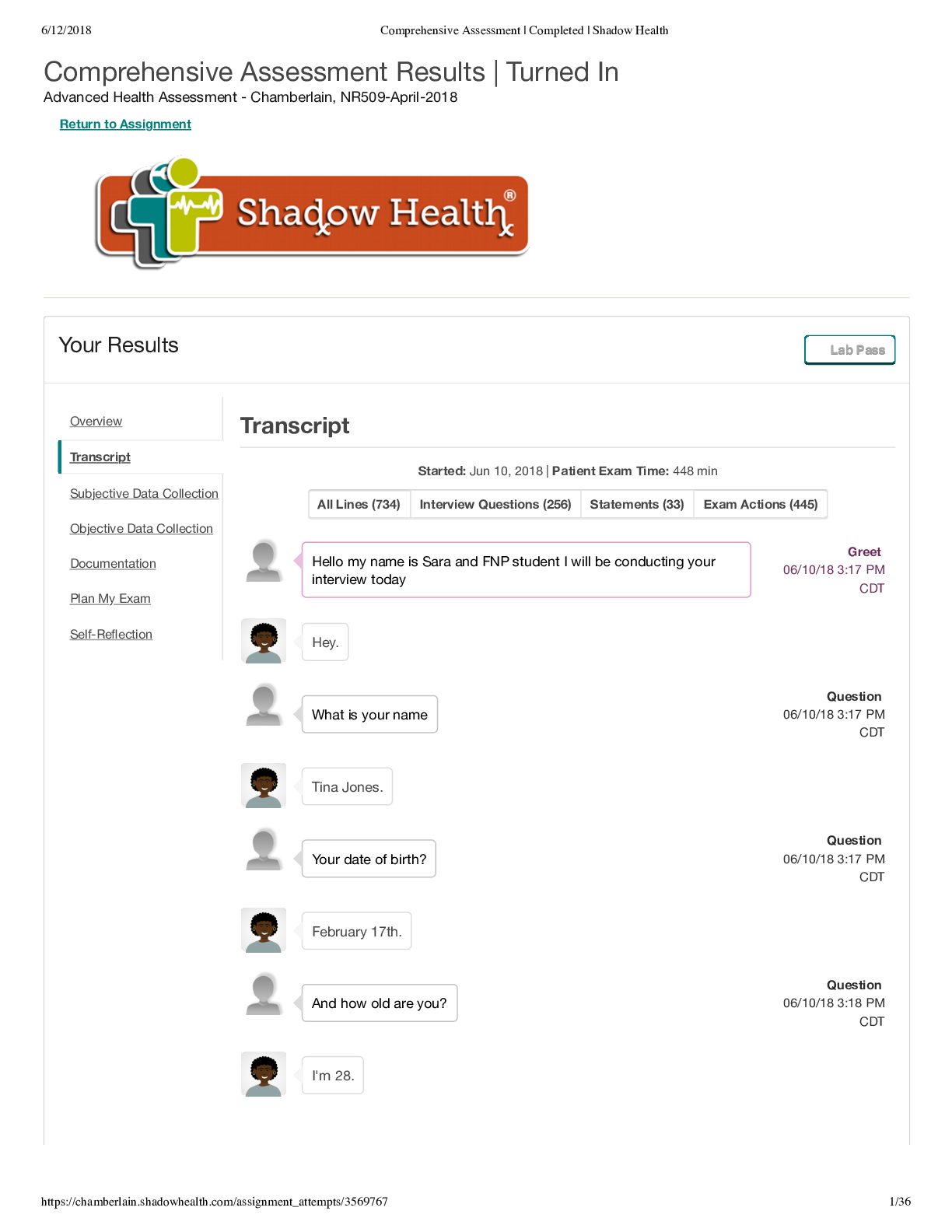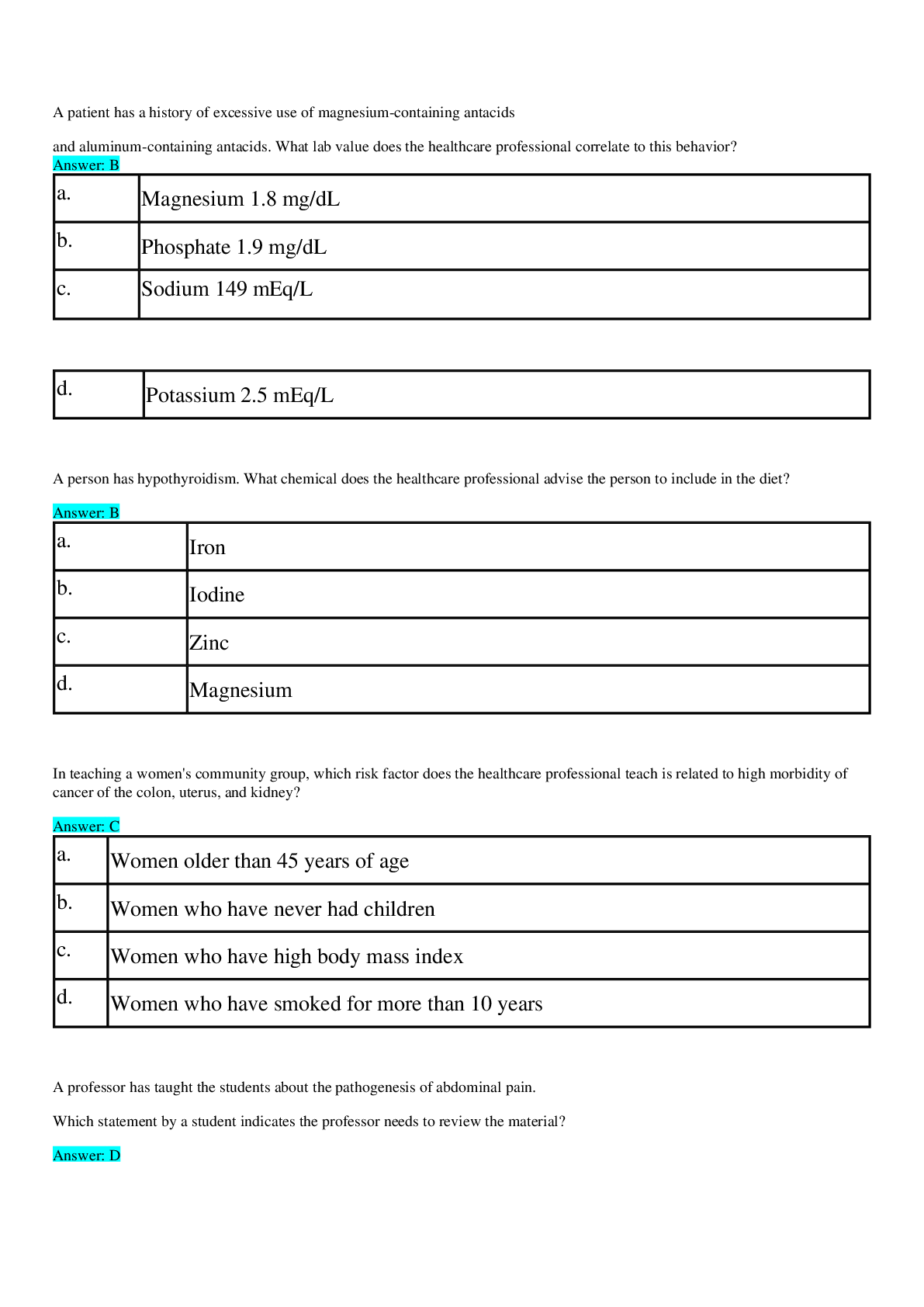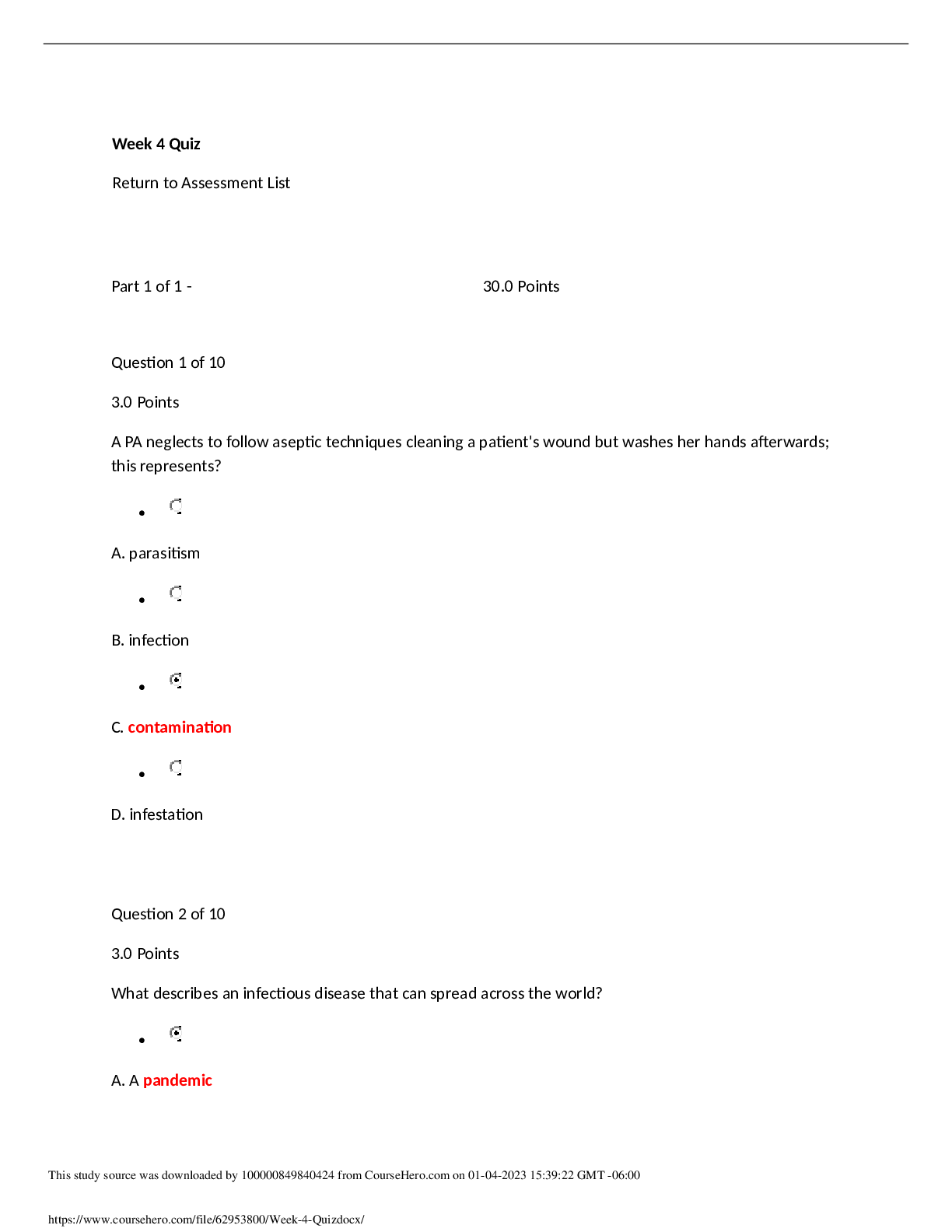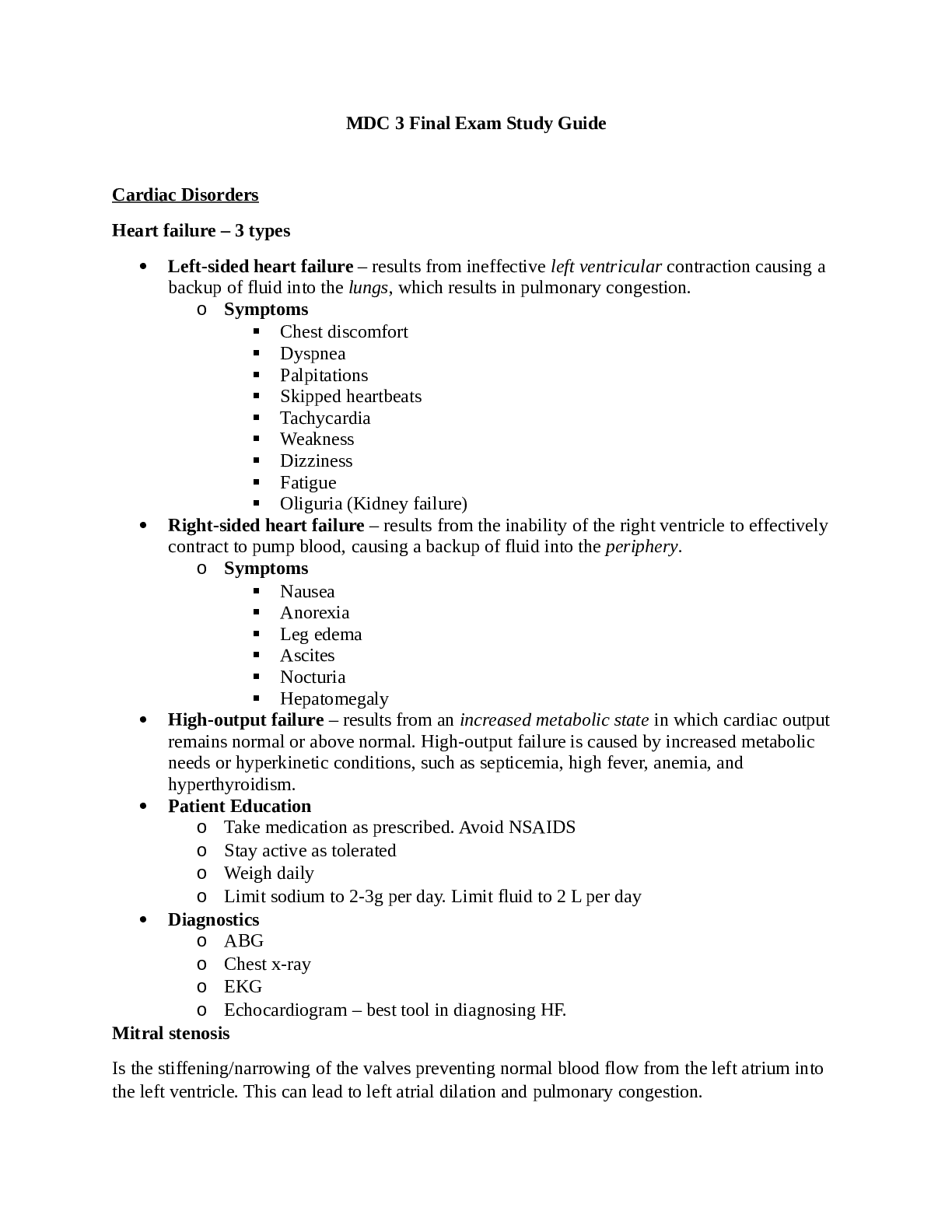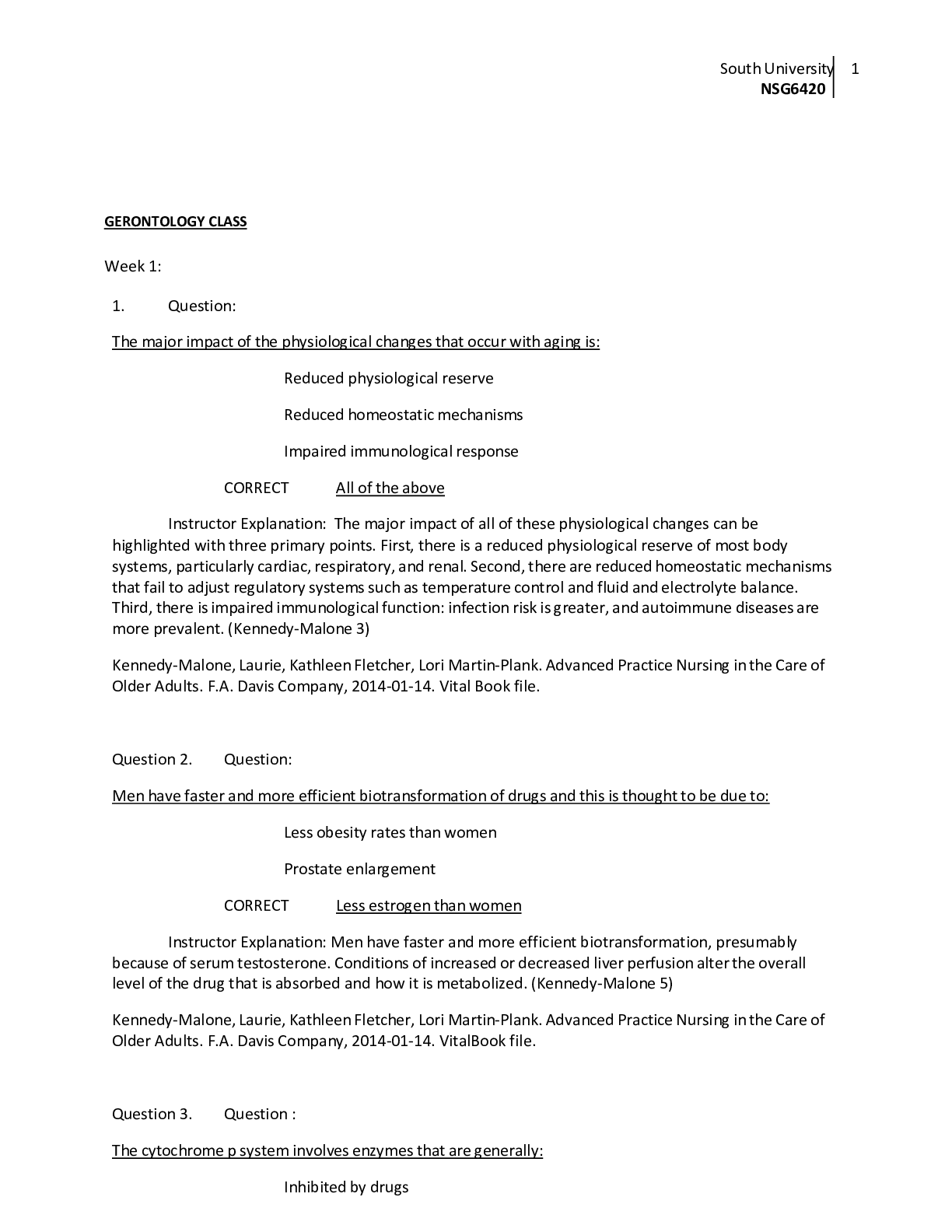Health Care > EXAM > Summary NR509 / NR 509 Midterm Exam Study Guide (Latest 2021 / 2022): Advanced Physical Assessment - (All)
Summary NR509 / NR 509 Midterm Exam Study Guide (Latest 2021 / 2022): Advanced Physical Assessment - Chamberlain
Document Content and Description Below
NR509 Mid-Term Study Guide • Articular structures include joint capsule and articular cartilage, the synovium and synovial fluid, intra-articular ligaments and juxta-articular bone o Articular di... sease involves: ▪ Swelling ▪ Tenderness of the joint ▪ Crepitus ▪ Instability “locking” ▪ Deformity ▪ Limits active and passive range of motion due to stiffness or pain • Extra-articular structures include periarticular ligaments, tendons, bursae, muscle, fascia, bone, nerve and overlying skin o Extra-articular disease involves: ▪ “point of focal tenderness in regions adjacent to articular structures ▪ Limits active range of motion ▪ RARELY causes swelling, instability, joint deformity Know the sources of joint pain (pg. 627 algorithm) • Nonarticular conditions: trauma/fracture, fibromyalgia, polymyalgia rheumatica, bursitis, tendinitis • Intra-articular (acute, < 6 weeks): acute arthritis o infectious arthritis o gout o pseudogout o Reiter syndrome • Intra-articular (chronic, > 6 weeks): chronic inflammatory arthritis vs chronic noninflammatory arthritis o Chronic inflammatory arthritis with 1-3 joints involved: ▪ Indolent infection ▪ Psoriatic arthritis ▪ Reiter syndrome ▪ Periarticular JA o Chronic inflammatory arthritis with >3 joints involved: ▪ Psoriatic arthritis or Reiter syndrome (no symmetry) ▪ rheumatoid arthritis if not RA then ! systemic lupus, scleroderma, polymyositis *Know what causes saddle numbness and urinary retention (pg. 678?) • CES (cauda equina syndrome) most commonly results from a massive herniated disc in the lumbar region. • A single excessive strain or injury may cause a herniated disc. • However, disc material degenerates naturally as a person ages, and the ligaments that hold it in place begin to weaken. As this degeneration progresses, a relatively minor strain or twisting movement can cause a disc to rupture. The following are other potential causes of CES: • Spinal lesions and tumors • Spinal infections or inflammation • Lumbar spinal stenosis • Violent injuries to the lower back (gunshots, falls, auto accidents) • Birth abnormalities • Spinal arteriovenous malformations (AVMs) • Spinal hemorrhages (subarachnoid, subdural, epidural) • Postoperative lumbar spine surgery complications • Spinal anesthesia Know how retinal detachment presents (p.217) • Sudden, painless vision loss that is unilateral Know what the word obtunded means (p. 769) • The obtunded patient opens eyes and looks at you but responds slowly and is somewhat confused. Alertness and interest in the environment are decreased. Know what cranial nerve you’re assessing when checking lateral gaze (p. 237) • Cranial nerve VI: abducens Know what should be listed under adult illnesses in health history (pg. 10) • Medical illnesses: such as diabetes, hypertension, hepatitis, asthma, and HIV. Also hospitalizations, number and gender of sexual partners, and risk-taking sexual practices • Surgical: dates, indications, and types of operations • Obstetric/Gynecologic: obstetric history, menstrual history, methods of contraception, and sexual function • Psychiatric: illness and timeframe, diagnoses, hospitalizations, and treatments Know what conditions do not have red reflexes (p. 239) • Absence of red reflex suggests an opacity of the lens (cataract), or possibly the vitreous (or even an artificial eye). • Less commonly, a detached retina, or in children a retinoblastoma may obscure this reflex. Know the signs of seasonal allergies (p. 27) • itching, watery eyes, sneezing, ear congestion, postnasal drainage Know how optic neuritis presents (p. 217) • Sudden visual loss that is unilateral and can be painful, associated with multiple sclerosis Know how pityriasis rosacea presents (p. 912) • Oval lesions on trunk, in older children often in a Christmas tree pattern, sometimes a Harold patch (a large patch that appears first) Know what is listed under present illness (p. 9) • Complete, clear, and chronologic description of the problems prompting the patient’s visit, including the onset of the problem, the setting in which it developed, it’s manifestation and any treatments to date. • (OLDCART) Onset, Location, Duration, Characteristics, Aggravating factors, Relieving factors, Treatments (past) Know where the acromion process is (be able to identify it on a picture) • Located between the clavicle and the shoulder *Know what to do if you have a + finding on physical exam but otherwise negative work-up (p. 30) Know what can cause falsely high BP’s (p. 127) • If the brachial artery is below the heart level, the blood pressure reading will be higher. If the cuff is too small (narrow) the blood pressure will read high. • If the cuff is too large (wide) the BP will read high on a large arm Know how to check for nystagmus (p. 737) • Nystagmus is seen in cerebellar disease especially with o gait ataxia o dysarthria (increases with retinal fixation o vestibular disorders (decreases with retinal fixation) o internuclear ophthalmoplegia • Identify any nystagmus, an involuntary jerking movement of the eyes with quick and slow components. • Note the direction of the gaze in which it appears, the plane of the nystagmus (horizontal, vertical, rotary, or mixed), and the direction of the quick and slow components. • Nystagmus is named for the direction of the quick component. • Ask the patient to fix his or her vision on a distant object and observe if the nystagmus increases or decreases. Know what yellow sclera indicates (p. 234) • A yellow sclera indicates jaundice Pg. 72 - Know how to get a patient to open up when he seems upset • The first step to effective reassurance is simply identifying and acknowledging the patient’s feelings. For example, you might simply say, “You seem upset today.” This promotes a feeling of connection. Meaningful reassurance comes later, after you have completed the interview, the physical examination, and perhaps some laboratory tests. At that point, you can explain what you think is happening and deal openly with any concerns. Reassurance is more appropriate when the patient feels that problems have been fully understood and are being addressed. • Another way to affirm the patient is to validate the legitimacy of his or her emotional experience. Saying something like, “Your accident must have been very scary. Car accidents are always unsettling because they remind us how vulnerable we are. Perhaps that explains why you still feel upset,” validates the patient’s response as legitimate and understandable • Moving closer or making physical contact like placing your hand on the patient’s shoulder conveys empathy and can help the patient gain control of upsetting feelings. The first step to using this important technique is to notice nonverbal behaviors and bring them to conscious level. Pg. 27 - Know the signs of degenerative pain Page 696 Pg. 289 - Know how otosclerosis presents with Weber and Rinne test Otosclerosis! condition that affects the tiny middle ear bone known as the stapes. • Stapes can become stuck, limiting its ability to vibrate (vibrations are crucial for hearing) • Conductive hearing loss • Weber test o Tuning fork at vertex o Sound is heard in the impaired ear o Room noise not well heard, so detection of vibrations improves • Rinne test o Tuning fork at external auditory meatus; then on mastoid bone o BC longer than or equal to AC (BC > AC or BC = AC) o While air conduction through the external or middle ear is impaired, vibrations through bone bypass the problem to reach the cochlea o The sound is heard longer through bone than air Pg. 183 – Know that cherry angiomas are benign Pg. 231 - Know how to interpret visual acuity results • Visual acuity is expressed as two numbers (e.g., 20/30): o First indicates the distance of the patient from the chart (20 feet), o Second, the distance at which a normal eye can read the line of letters ▪ Vision of 20/200 means that at 20 feet the patient can read print that a person with normal vision could read at 200 feet. • The larger the second number, the worse the vision. • “20/40 corrected” means the patient could read the 20/40 line with glasses (a correction). • A patient who cannot read the largest letter should b [Show More]
Last updated: 1 year ago
Preview 1 out of 29 pages
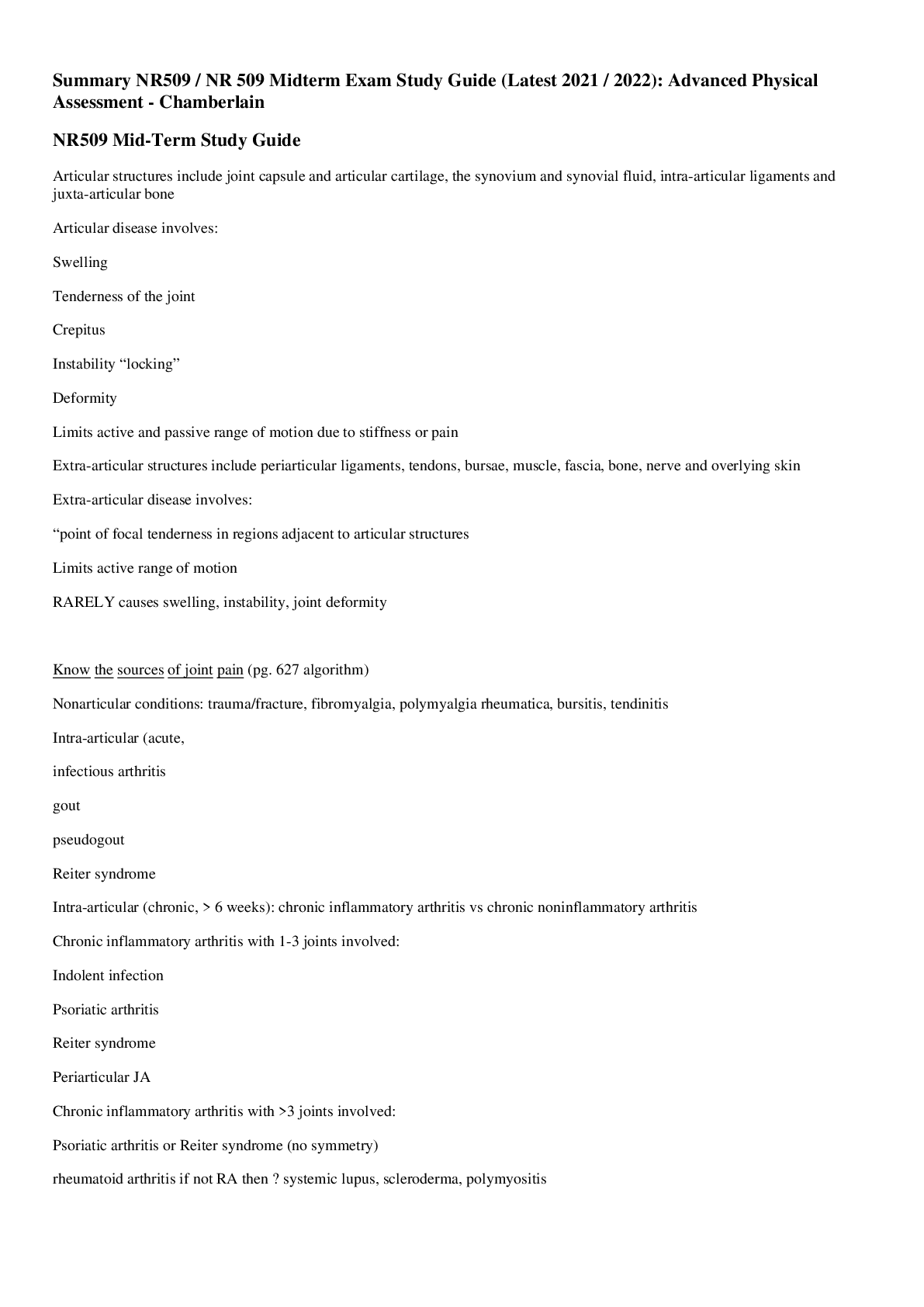
Reviews( 0 )
Document information
Connected school, study & course
About the document
Uploaded On
Aug 04, 2022
Number of pages
29
Written in
Additional information
This document has been written for:
Uploaded
Aug 04, 2022
Downloads
0
Views
30


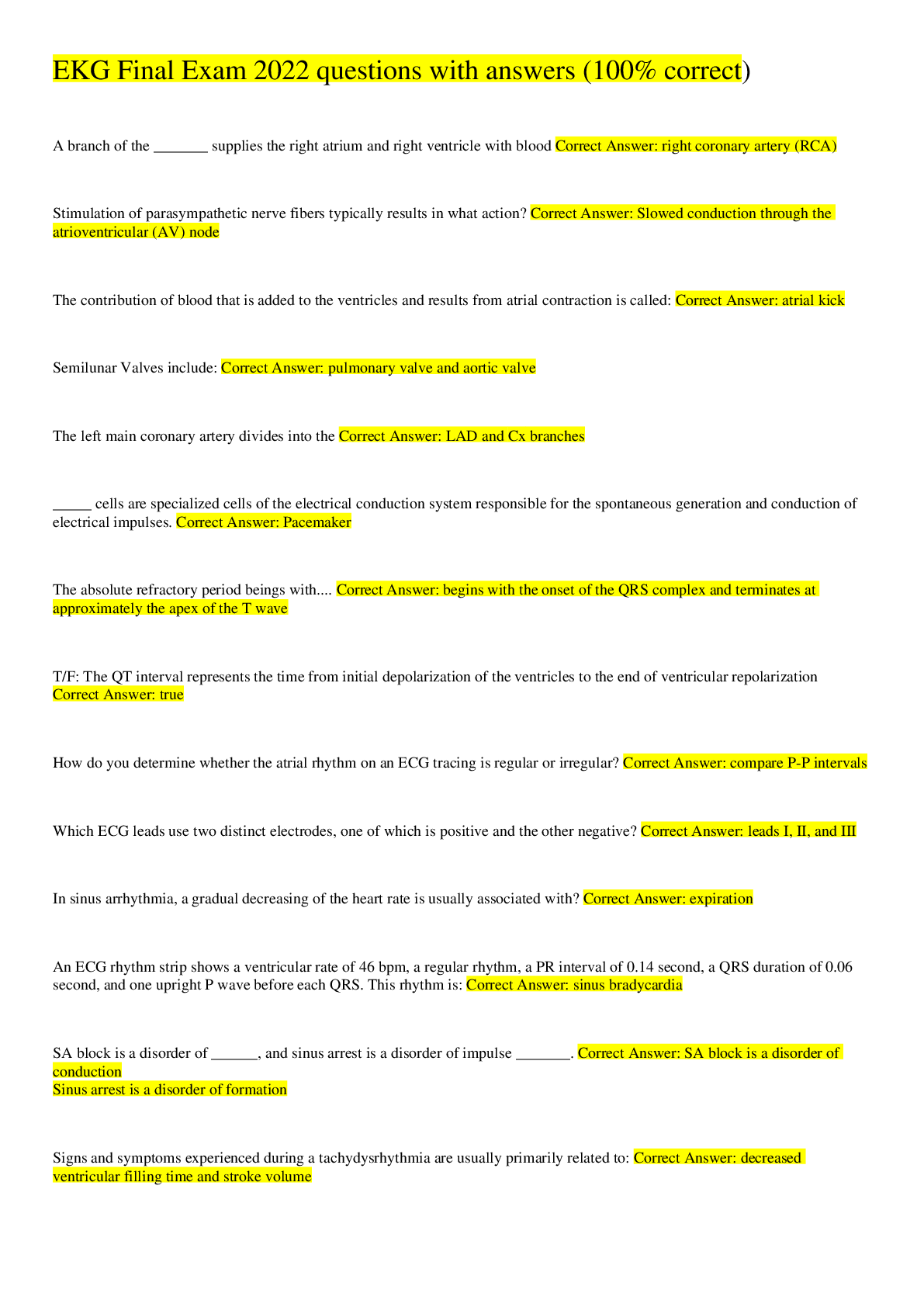
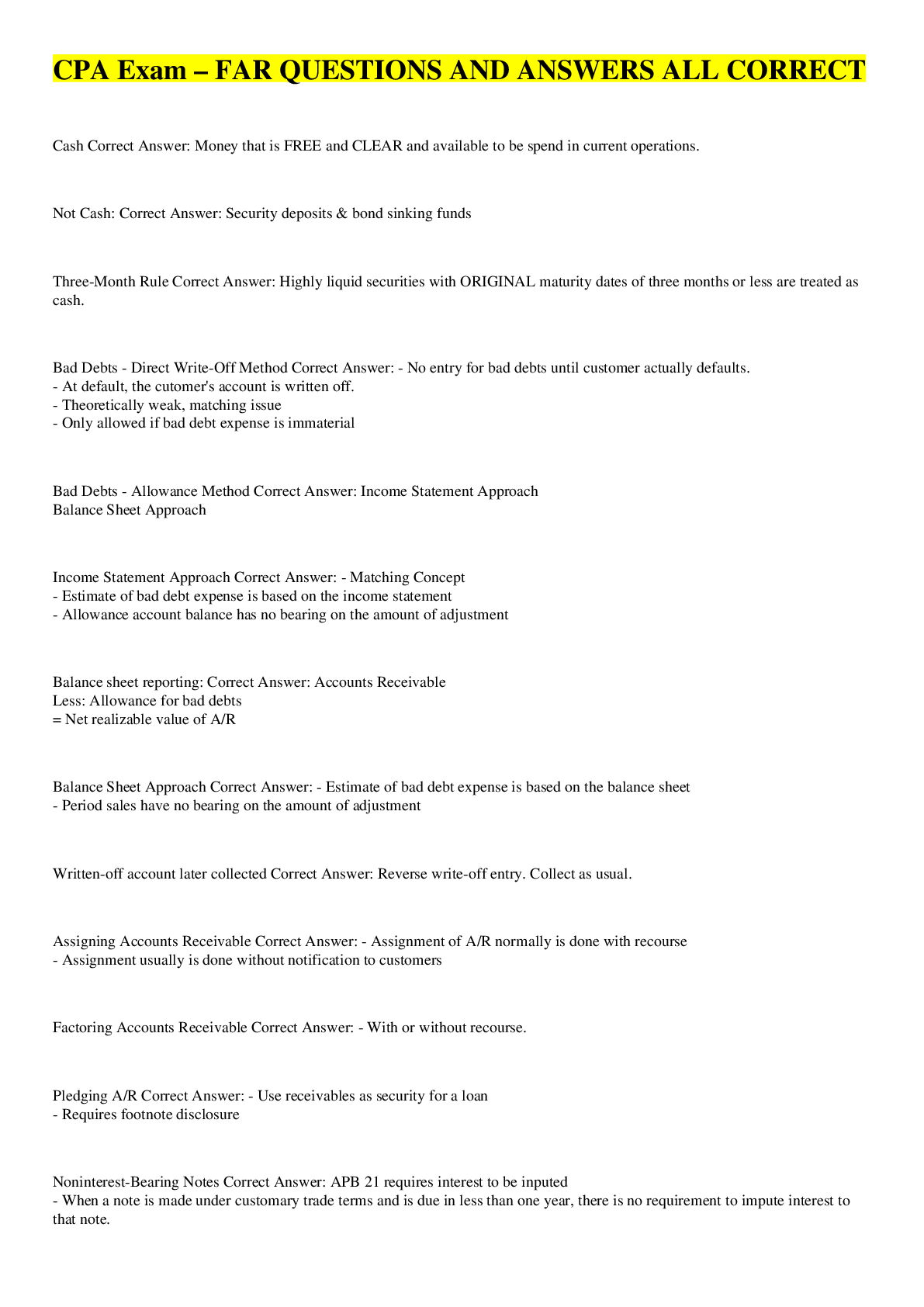
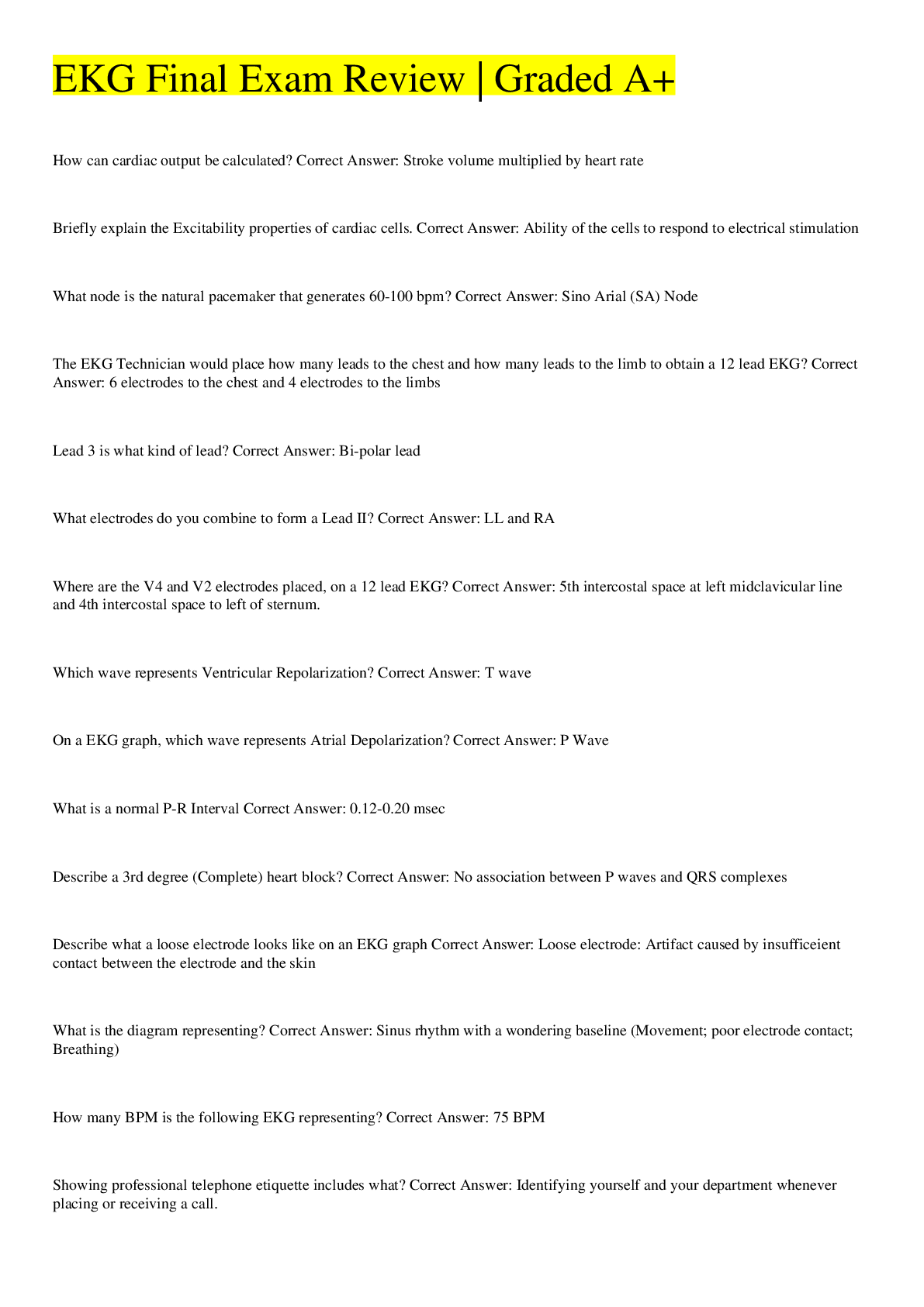
.png)

